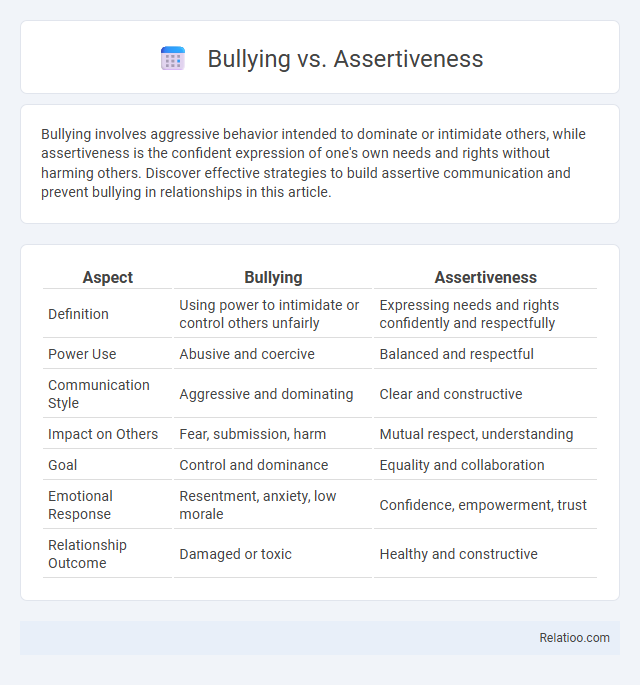Bullying involves aggressive behavior intended to dominate or intimidate others, while assertiveness is the confident expression of one's own needs and rights without harming others. Discover effective strategies to build assertive communication and prevent bullying in relationships in this article.
Table of Comparison
| Aspect | Bullying | Assertiveness |
|---|---|---|
| Definition | Using power to intimidate or control others unfairly | Expressing needs and rights confidently and respectfully |
| Power Use | Abusive and coercive | Balanced and respectful |
| Communication Style | Aggressive and dominating | Clear and constructive |
| Impact on Others | Fear, submission, harm | Mutual respect, understanding |
| Goal | Control and dominance | Equality and collaboration |
| Emotional Response | Resentment, anxiety, low morale | Confidence, empowerment, trust |
| Relationship Outcome | Damaged or toxic | Healthy and constructive |
Understanding Bullying: Definition and Core Traits
Bullying is characterized by repeated aggressive behavior intended to harm or dominate others, often involving an imbalance of power and resulting in emotional or physical distress. Assertiveness, in contrast, involves confidently expressing one's thoughts and needs without violating others' rights or resorting to aggression. Understanding bullying requires recognizing its core traits: intentionality, repetition, and power imbalance, which distinguish it from assertive communication and help target effective prevention and intervention strategies.
Assertiveness Explained: Healthy Communication in Action
Assertiveness is the ability to express thoughts, feelings, and needs honestly and respectfully without infringing on others' rights, distinguishing it clearly from bullying and passive behavior. It promotes healthy communication by fostering mutual respect, setting clear boundaries, and encouraging open dialogue essential for conflict resolution and emotional intelligence. Unlike bullying, which involves manipulation and dominance, assertiveness empowers individuals to advocate for themselves while maintaining empathy and cooperation in interactions.
Key Differences Between Bullying and Assertiveness
Bullying involves aggressive behavior intended to intimidate or harm others, often repeated and targeted, while assertiveness is the confident expression of one's needs and rights without violating others' boundaries. The key differences lie in intent and impact: bullying seeks control and causes emotional or physical harm, whereas assertiveness promotes respectful and clear communication, fostering mutual understanding. Recognizing these distinctions helps individuals maintain healthy interactions and protect personal boundaries effectively.
The Psychology Behind Bullying Behaviors
The psychology behind bullying behaviors reveals a complex interplay of power dynamics, insecurity, and unmet emotional needs driving individuals to harm others. Assertiveness involves confidently expressing your thoughts and feelings without infringing on others' rights, contrasting sharply with bullying, which seeks to dominate or intimidate. Understanding these psychological factors helps you distinguish between healthy self-expression and harmful aggression.
Benefits of Assertiveness in Personal Development
Assertiveness fosters effective communication, enhances self-confidence, and promotes healthy boundaries, essential for personal development. Unlike bullying, which harms relationships and self-esteem, assertiveness encourages respect without aggression, enabling individuals to express their needs clearly. Developing assertiveness skills leads to improved conflict resolution and emotional intelligence, contributing to long-term personal growth and well-being.
Identifying Signs: Am I Being Assertive or a Bully?
Identifying signs to distinguish assertiveness from bullying involves recognizing respect and intent in your communication; assertiveness is expressing your needs confidently and respectfully without undermining others, while bullying involves aggressive, manipulative, or harmful behavior aimed at controlling or belittling. Your tone, body language, and willingness to listen to others' perspectives are key indicators--assertiveness respects boundaries, whereas bullying disregards them. Being mindful of these signs helps you maintain healthy interactions and avoid crossing the line from standing up for yourself to dominating others.
Impact on Mental Health: Bullying vs Assertiveness
Bullying inflicts lasting damage on mental health, often causing anxiety, depression, and diminished self-esteem, whereas assertiveness promotes healthy communication and builds confidence. Your ability to express needs clearly without aggression fosters resilience and emotional well-being. Unlike bullying, assertiveness strengthens relationships and supports positive psychological outcomes.
Strategies to Transform Bullying into Assertiveness
Implementing clear communication techniques and establishing firm personal boundaries are essential strategies to transform bullying into assertiveness. Teaching individuals to express their needs confidently and calmly reduces the impact of aggressive behavior and promotes mutual respect. Utilizing role-playing scenarios and conflict resolution training further empowers victims to respond assertively rather than react passively or aggressively.
Teaching Assertiveness Skills in Schools and Workplaces
Teaching assertiveness skills in schools and workplaces empowers individuals to express their thoughts and feelings confidently without resorting to bullying or passivity. Assertiveness training fosters clear communication, respect, and boundaries, reducing incidents of bullying by promoting empathy and self-confidence. Your ability to differentiate and practice assertiveness enhances a positive environment, improving interpersonal relationships and overall well-being.
Building a Culture of Respect: Preventing Bullying, Promoting Assertiveness
Building a culture of respect requires distinguishing bullying, which involves harmful, repetitive behaviors intended to intimidate or control, from assertiveness, characterized by confident and respectful self-expression. You can promote assertiveness by teaching clear communication skills and encouraging empathy, helping individuals set healthy boundaries without aggression. Preventing bullying involves implementing consistent consequences, fostering safe environments, and empowering bystanders to intervene effectively.

Infographic: Bullying vs Assertiveness
 relatioo.com
relatioo.com